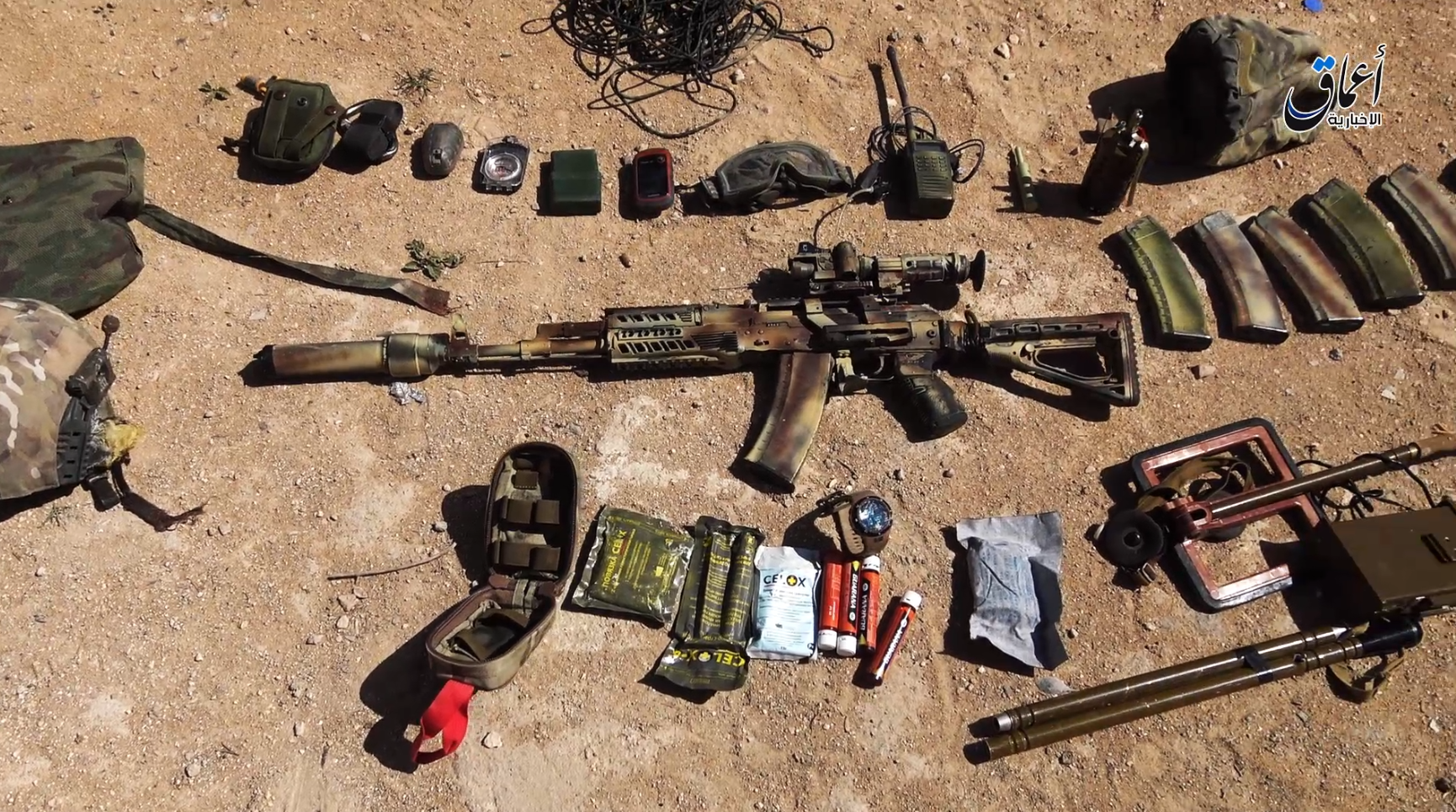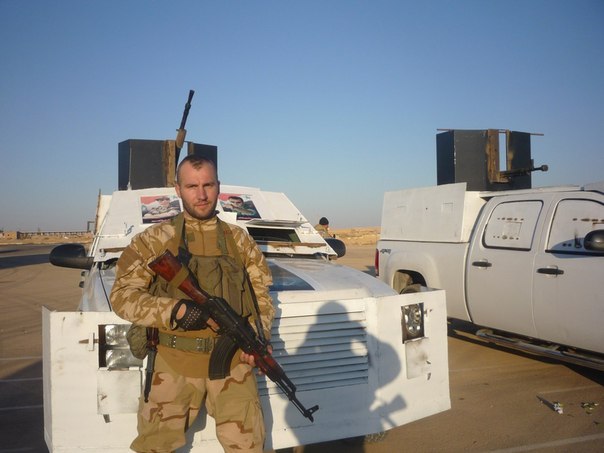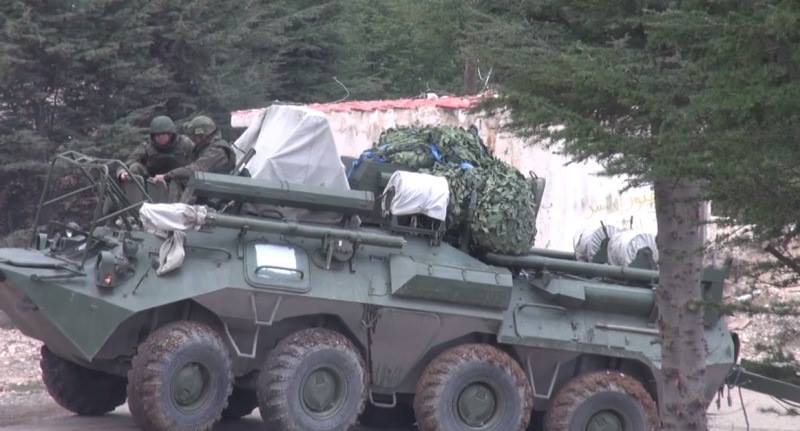This month has seen President Vladimir Putin announcing the withdrawal of the “main part” of the Russian military deployment in Syria and confirming the deaths of five servicemen during the campaign that began on September 30, with the death of another reported independently. But while the Kremlin is presenting this as “mission accomplished,” the military operation is continuing in Syria, albeit more quietly, and the death toll continues to rise.
On March 17, three days after Putin announced the withdrawal, ISIS claimed to have killed five Russian soldiers over two days near Palmyra in eastern Homs. The group released a video, showing the body of one man and his equipment, and also published a photo of another corpse.
The equipment seen in the video includes a Kalashnikov AK-74M, festooned with tactical rail accessories and equipped with a thermal imaging system and suppressor.

Armaments Research Services (ARES) notes one particular piece of hardware that indicates the man was part of a Russian special forces team.

This is an MIB multi-function munition – a weapon adopted by the Russian military as recently as 2007 and associated with special operations forces. It can be deployed as either a hand grenade or a landmine, capable of deploying its own tripwires.
The metal detector, pull cord and several packets of Celox anti-coagulant agent would all be useful tools for a fighter out on reconnaissance missions in territory littered with IEDs and mines.
The Amaq News Agency, a semi-official press outlet for ISIS, while referring to the dead man in the video as an “adviser,” claimed that four Russian soldiers had been killed in a separate incident in the same area.
Amaq published a photo of one dead man and images purportedly taken from the cellphone of one of the dead Russians.
The deceased is clearly recognizable as one of the men seen in the photos. But while they are armed with Russian-made equipment and pose with the traditional insignia of Russian military intelligence, it can not be said for sure which unit these men served with. The distinctive bat emblem of Russia’s spetsnaz (special forces) was officially withdrawn in 2002 and, while still regularly used informally by such troops, it is also widely displayed by fighters outside the military intelligence directorate. The dead man is seen wearing the telnyashka or striped t-shirt of the Russian airborne forces (VDV), but once again, this item can be purchased elsewhere.
Could the men seen in the pictures be mercenaries instead of Russian spetsnaz? Such forces are indeed known to have fought on the side of the Assad regime, most notoriously Russia’s Slavonic Corps outfit which deployed to this same area in 2013.

Russian mercenaries, working for the Slavonic Corps, fighting in Syria | VK
Dr Igor Sutyagin, a senior research fellow at the Royal United Services Institute (RUSI), told The Interpreter that it would be impossible to distinguish fighters from Russian private military contractors from other insignia-less special forces units. This is because unlike Western PMCs, these Russian companies are organised “to participate in combat operations” rather than provide security assistance. Kitted out by the Russian military and deployed as combat fighters like any others, they allow the Kremlin a degree of plausible deniability as they lack the usual paper trail of unit numbers and permanent home bases. This is especially useful if casualties are incurred.
That at least two Russian fighters have been killed in the Palmyra area in recent days should not be a surprise.
Russia has been building up a military presence in this area for a while now and, despite the “draw-down” is now working with the Syrian regime to mount what is only the second major offensive action against ISIS of the Russian intervention, the first being airstrikes in support of Syrian regime forces relieving the besieged Kweres airbase east of Aleppo.
Back in February, CNN filmed Russian troops with BTR-82A armoured personnel carriers, T-90 tanks, 152 mm howitzers and Kamaz artillery tractors on the front line near Palmyra.
On March 9, Kamel Saqr, a Syrian journalist, reported significant movements of Russian forces towards Palmyra, including armor and artillery.
He posted a photograph of a Russian R-166-0.5 signals vehicle on the move:

Two days before ISIS made their claims, Russian war pornographer Aleksandr Pushin, who specializes in drone videos from the battlefields of Syria, uploaded video of a purported ISIS attack, reportedly near Palmyra:
https://youtu.be/lGkrkhXA8GU
These forces have been pressed into action, with intense air strikes on ISIS-held Palmyra, supporting advances by regime and Iraqi Shia militia fighters on the ground.
On March 22, the Palmyra Revolution Coordination group, made up of activists opposing both the Assad regime and ISIS, released a statement claiming that Russian air strikes had devastated both residential areas and the nearby ruins of the ancient city.
https://twitter.com/PalmyraRev1/status/712234788237742080
According to the group, Russian jets destroyed a mosque and continue to use cluster munitions. They also report the use of Scud missiles, most likely by Syrian regime forces.
The indiscriminate nature of the Russian bombardment is testified to by reports from staunchly pro-regime sources that 17 regime soldiers were killed by a Russian missile on Monday in a “friendly fire” incident.
Russian state media is now citing Syrian military sources as saying that the regime has regained control over the ancient area of the city, while the anti-Assad Syrian Observatory for Human Rights claims that regime forces are within two kilometers of the site. Yevgeny Poddubny, a star propagandist for Russian state television, tweeted at 13:44 GMT:
Бои продолжаются в непосредственной близости от Пальмиры, пока САА в город не вошли. Следим на месте
— Evgeny Poddubnyy (@epoddubny) March 23, 2016
Translation: Battle continues in the immediate vicinity of Palmyra, the Syrian Arab Army has not yet entered the town. We’re following on the scene.
The recapture of the ancient city of Palmyra would be a huge propaganda boon for both the Assad regime and the Kremlin. The destruction of Palmyra’s historic artifacts by ISIS has been one of the most striking symbols of the group’s barbarity (perhaps even more so in some corners than their cruelty to the captives). Having already declared a victory of sorts, Putin could then claim the title of the defender of history.
But there are greater strategic factors that make the capture of Palmyra so vital for the regime.
The town sits in a sparsely-inhabited stretch of desert, on the road between Damascus, to the southwest, and Deir ez-Zor, and ultimately Iraq, to the east. It was on this very road that ISIS first advanced into Syria from Iraq in 2014. With almost no nearby population centers and open terrain, ISIS can move forces to within 200 kilometers of the capital without observation. The regime therefore sees retaking the town as key to ensuring the security of Damascus and Homs.
In addition, Palmyra is surrounded by some of Syria’s most productive gas fields, and serves as the hub for the vast majority of Syria’s gas production.
Yezid Sayigh wrote for the Carnegie Endowment last year:
Fields in the area were expected to eventually produce 9 million cubic meters of crude gas per day. These included the Arak, Dubayat, Hail, Hayan, Jihar, al-Mahr, Najib, Sukhneh, and Abi Rabah fields, which according to a former industry insider have collectively been producing half of Syria’s output of natural raw and liquid petroleum gas. Palmyra is also the transit point for pipelines carrying gas from important fields in Hasakah and Deir Ezzor provinces in northeastern and eastern Syria respectively.
It is these security and economic concerns that drive the regime offensive on Palmyra, rather than a renewed commitment to fighting ISIS, just as the Russian “Slavonic Corps” mercenaries were deployed here in 2013
While Russian jets and helicopters have stepped up attacks on ISIS in Palmyra, they still ignore the terrorist group in the south, where ISIS has recently been the advance against Syria opposition fighters in the Daraa province, as they have throughout almost all of the air campaign.